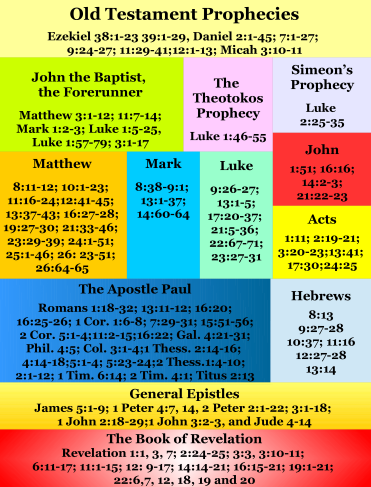Second Edition

If I Was a Futurist and I Saw the Evidence
Preterists Present What Would Make
Me Pause or Equivocate?
by Mark Mountjoy
It would be a mistake to believe that some people who do not commit to Preterism or hesitate to consider it as nothing more than a new heretical distraction do so solely for convenient reasons such as their reputation, relationships, or economic concerns. Truly understanding someone else's perspective requires a great deal of patience and a willingness to empathize with their concerns. What may be troubling them might not align with our assumptions and may not always be obvious. Instead of becoming defensive and turning a chance to learn from them into an argument or debate (as we could potentially be incorrect), we should remain open-minded and ask them directly about their concerns. However, if we refuse to listen to anything other than our own thoughts and justifications, there is no way for us to truly know.?

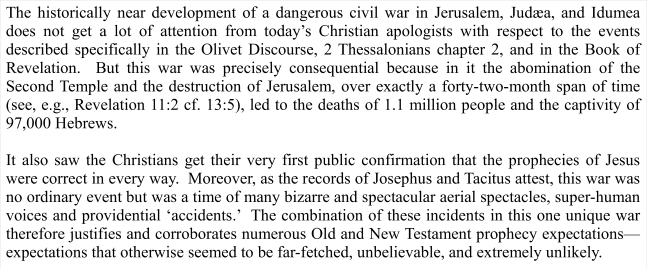 From our perspective, we may be at fault for speaking only to those who share our beliefs and not realizing how we may be perceived by others. This applies to me as much as anyone else, which is why it is crucial for Christians to communicate with a diverse range of other Christians. We do not have to agree completely with everyone, and God does not expect us to. While we have the freedom to choose not to participate in certain holidays, traditions, or practices in our worship, the topic of a past Second Coming can become complicated when we deceive ourselves into thinking it is a clear-cut issue in the eyes of others who are observing. There comes a point when our reasoning strikes a chord because it aligns so closely with the truth that it is hard for anyone to overlook. When we discuss what Jesus and the Apostles expected, and what the early Christians hoped for, most people, if they are familiar with the New Testament, already understand that the Second Coming was anticipated to occur a long time ago.
From our perspective, we may be at fault for speaking only to those who share our beliefs and not realizing how we may be perceived by others. This applies to me as much as anyone else, which is why it is crucial for Christians to communicate with a diverse range of other Christians. We do not have to agree completely with everyone, and God does not expect us to. While we have the freedom to choose not to participate in certain holidays, traditions, or practices in our worship, the topic of a past Second Coming can become complicated when we deceive ourselves into thinking it is a clear-cut issue in the eyes of others who are observing. There comes a point when our reasoning strikes a chord because it aligns so closely with the truth that it is hard for anyone to overlook. When we discuss what Jesus and the Apostles expected, and what the early Christians hoped for, most people, if they are familiar with the New Testament, already understand that the Second Coming was anticipated to occur a long time ago.
To be fair to the majority of Christians, they may argue that there are valid circumstances explaining why it has not happened yet. They may refer to Revelation 20 and come to the conclusion that it provides explanations for how it fits into the past, if we consider everything in Biblical eschatology to be already fulfilled.
And this is exactly where we may encounter difficulties when we come across larger issues such as interpreting the meaning of Revelation 20. If it is true that Jesus returned during the Jewish turmoil from 66-70 A.D., people may acknowledge that it was a coming of the Lord, but they may hesitate to claim it was the Great White Throne Judgment. Full Preterist believe the Great White happened in the A.D.70 event but if they cannot logically explain how this arrangement aligns smoothly within the historical timeframe of 33-70 A.D, that is a problem.
If, on one hand, our evidence regarding time statements and context cannot be refuted or denied, but our reasoning regarding Satan being bound and then loosed cannot be logically explain, then we would be in a problematic situation. In other words, two opposing claims about the same event cannot be simultaneously true.
Is it possible for Satan to be bound during the final forty years of Second Temple Judaism and also be also be loosed during the same period? When we merge these conflicting ideas, it simply does not make sense!
I would also like to communicate openly with the Christians who come from a Restoration Movement background and remind you of something that I believe you already know very well. On the day of Pentecost, the Apostles, Jews, Israelites, and proselytes had a positive relationship with one another. They were,
“. . .continuing daily with one accord in the Temple, and breaking bread from house to house, did eat their meat with gladness and singleness of heart, praising God and having favor with all the people, and the Lord added to the church daily such as should be saved” (Acts 2:46-47).
Therefore, it is probably agreed upon that the beheading of Christians by the beast did not occur on the day of Pentecost, as Luke does not mention or imply this in the Book of Acts. The only mention of such a harsh treatment of Christians appears in Revelation 13:15. Hence, this is another reason why Revelation 20:1-4 cannot be connected to anything that happened in the 29-year timeframe covered by Luke in Acts. Consequently, I would be cautious and hesitant to accept any theoretical explanation that presents an A.D.70 endpoint as an unquestionable fact, especially if someone fails to clarify how and why Satan could occupy two opposing positions simultaneously.
This inability to explain something indirectly suggests that we may not have a comprehensive understanding beyond the aspects related to time statements and the expectations of Jesus and the Apostles. If we start speculating when analyzing Revelation 20, it implies that fifteen crucial verses either support or contradict our claims about the significance of A.D.70. In such a case, the verdict would be: it is not a valid proposition.
Furthermore, the historical events of the tragic suicides at Masada during Passover in A.D. 73 and the catastrophic rebellions in the Diaspora that shook the Roman Empire during the reign of Trajan resulted in the deaths of more than 450,000 Roman citizens.
These violent uprisings continued until A.D. 117. Additionally, a violent insurrection occurred in Judaea in A.D. 132, which initially succeeded and lasted exactly three years and six months. According to the Rabbis, this rebellion resulted in the deaths of millions of people. Many theologians and Bible scholars are aware of this event, known as the Bar Kokhba rebellion, although their understanding may be somewhat limited. However, this knowledge is sufficient for them to speculate that A.D. 70 was not an absolute deadline for any Jewish attempts to achieve their militant Messianic goals.
When Preterist scholars, apologists, and authorities resist and refuse to connect Masada, Judæa Capta, the Expeditio Judaica and the downfall of Bar Kokhba to the Bible's prophetic narrative, it directly hinders their ability to convince others of the ultimate logical conclusions of their views.
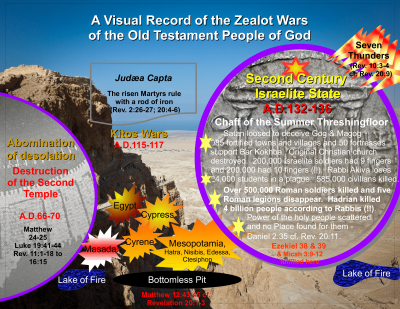
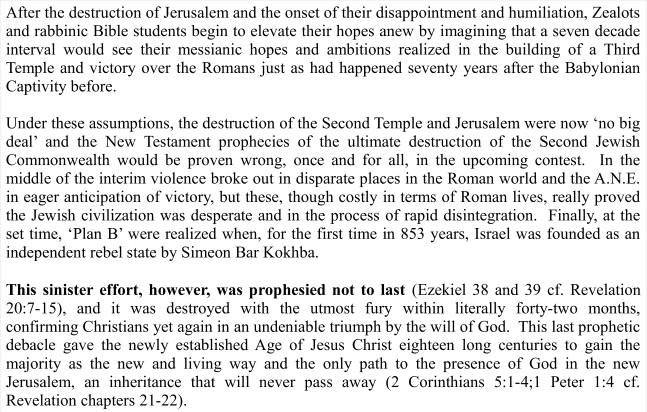 Therefore, in my opinion, the suggestion that Revelation 19:21 ends in A.D.70 but Revelation 20:1 opens up on the Day of Pentecost in A.D.33 seems like a red flag because it seems entirely unjustified. But if one were to reject Preterism's concept of recapitulation in Revelation 20:1 and continue onwards it would become evident that Jewish and Israelite ambitions ultimately led to their own downfall, as prophesied in the Bible and realized in the Bar Kokhba Revolt during the second century.
Therefore, in my opinion, the suggestion that Revelation 19:21 ends in A.D.70 but Revelation 20:1 opens up on the Day of Pentecost in A.D.33 seems like a red flag because it seems entirely unjustified. But if one were to reject Preterism's concept of recapitulation in Revelation 20:1 and continue onwards it would become evident that Jewish and Israelite ambitions ultimately led to their own downfall, as prophesied in the Bible and realized in the Bar Kokhba Revolt during the second century.
Full Preterism prematurely, arbitrarily, and artificially concludes all Bible prophecy events in A.D. 70 and neglect Revelation chapter 20 as a continuation of the events portrayed in Revelation chapter 19. They insist, instead, that Revelation 20:1-4 basically describes some truth about the Day of Pentecost in A.D. 33 and this, dear friends, is challenging, if not impossible, to explain or justify.
Conclusion
I am writing this not because I have all the answers, but because I hope that Christians will be open to exploring broader issues and engaging in discussions and debates with love and respect. Our message will lack depth and refinement if we choose to ignore or only debate with those who outright disagree with us. I think it is a big mistake that Full Preterists think having discussion with Atavist is not worth the time of day and it is possible that their overall argument may not seem to be narrow-minded or irrational, but making the Romans the fourth kingdom and having everything end in A.D.70, and turning Revelation 20 back into the A.D.33-70 period has the effect of demanding certain things be true of the Roman Empire that we know are not true at all: The Roman Empire did not end in A.D.70 and making Revelation 20:1-4 be about Pentecost A.D.33 is a brazen error that all Full Preterist need to see as such.
Rabbi Akiba’s Messiah
Daniel Gruber (Author)
Book description: It is not easy to overestimate the significance of the Bar Kokhba Revolt. Because of its long-term consequences, it may well be considered the greatest tragedy in Jewish history. It is the most defining. It set the stage for what became an endless procession of Jewish suffering down to, including, and beyond the Holocaust. The disaster was further compounded by the fact that Rabbi Akiba, the father of rabbinic Judaism, proclaimed Bar Kokhba, the leader of the rebellion, to be God’s Anointed, the Messiah.
In the eighteen hundred and fifty years since, as students of History and various religious persuasions have studied the sparse and sometimes conflicting evidence, one puzzling question always emerges. As Franz Rosenzweig expressed it, “Why did even the wisest teacher of his age fall for the false messiah, Bar Kokhba, in the time of Hadrian?” This book answers that question. Elijah Publishing
Part Two
Scripture text: “For Moses truly said unto the fathers, A prophet shall the Lord your God raise up unto you of your brethren, like unto me; him shall ye hear in all things whatsoever he shall say unto you.
And it shall come to pass, that every soul, which will not hear that prophet, shall be destroyed from among the people. Yea, and all the prophets from Samuel and those that follow after, as many as have spoken, have likewise foretold of these days” (Acts 3:22-24).
After reflecting on my experience in 1981, when I initially believed that Jesus had already returned, I have identified several ideas that Christians may struggle with, causing them cognitive dissonance. These conflicts need to be addressed and resolved. Individuals must be open to embracing a radically different understanding of these concepts in order to truly comprehend what occurred in the past. Otherwise, the truth will continue to elude them, despite its apparent visibility.
If Christians come from a certain apocalyptic understanding, they will likely have certain expectations about the end of the world that does not include a  vision of hills, mountains, valleys, and plains full dead bodies, weapons, and horses.
vision of hills, mountains, valleys, and plains full dead bodies, weapons, and horses.
They have been taught that the earth will suddenly be will simply destroyed by a great heat during the Second Coming of our Lord (2 Peter 3:10ff). They very likely will not associate Apostle Peter's reference to the end to what we read in Jeremiah 4:23 or Isaiah 13 or 34.
Instead, 2 Peter 3:10 will be seen as a literal event that will occur after God, in his wisdom and in his own time, determines that everything on earth has been said and done. Therefore, from this perspective, the end cannot be something that has already happened but rather it must be something that will happen in the future.
In other words, most Christians who hold this belief do not place much importance on the descriptions of destruction and carnage portrayed in Ezekiel chapters 38:18-23 and 39:2-11; Isaiah 66:22-24; and Revelation 19:17-21, or how the fulfillment of Ezekiel's and Isaiah's prophecies is implied in Revelation 20:7-9.
To be fair and understanding, it is important to recognize that they have a completely opposite understanding of what the Scriptures say about the end of the world and the changing of eras. Most Bible students do not realize that the focus of the Bible is actually on the inevitable sudden disappearance of the Hebrew civilization with its customs and traditions.
These include the engraved statutes on stones, the earthly sanctuary, the Aaronic priesthood, and the daily sacrifices and offerings, as well as the observance of Pesach, Shavuot, and Sukkōt (three annual convocations in Jerusalem), and their desire for a Messianic king and prophet-priest. They struggled to preserve these traditions by rebelling against the Romans.2 3 4 5 6
We must make a great effort to bridge the gap and help people understand that Jewish attempts to hold onto the Second Temple were misguided because they believed that God would intervene and help them achieve their goals during the First Great Revolt, but He did not.
In the Second Great Revolt, Bar Kokhba boldly stated that they did not need God's help and that they would be victorious on their own but this haughtiness was a disastrous mistake, leading to unimaginable destruction and loss of life, which took months to clean up and bury in the Dibon valley on the Jordanian side of the Dead Sea.7(31.4982° N, 35.7799° E) To my knowledge an excavation of the site has not happened to this day. However, the Full Preterist interpretation about the end of the world has NO CONCLUSION since we may say with certainty from our own examination that the expectations of the New Testament history just seventy out from the destruction of Jerusalem does not show up in any Full Preterist research and this ending is what is surprising and unfortunate: People prefer certainty to uncertainty and the Full Preterist interpretation ends with questions but not any historical facts.
From my own experience, when I first saw the possibility that Jesus may have already returned it still took me six months before I finally found Josephus' reports of chariots and troops of soldiers in the skies over the skies of Jerusalem and Judæa in the first century.8
I am saying all of this to really convey that we need to give people the space to go from thinking this is unthinkable, to ‘it’s possible,’ it’s probable, to it’s undeniable. That seldom happens right away and will certainly not happen unless reasons to believe don’t accrue in favor of a different opinion about, for example, Daniel 7:13, Matthew 16:27-28 and Acts 1:11 (the Ascension).9
The ‘Overton Window’ Problem We
Have to Face Up to and Navigate
However, our view does not deny the reality of John's vision of the new Jerusalem but asserts that it exists and will be rewarded to Christians who walk in faith and obedience. To make progress in the mainstream, we should present our ideas in an appealing and non-threatening way and be willing to defend our claims. Currently, most Christians believe that these explosive events will happen around the corner or at the end of time, making reorientation difficult for many.
When addressing issues regarding Realized Eschatology, Christians will encounter a messaging phenomenon. The most obvious problem is that few people have ever heard of it. Additionally, many Christians have not considered the core beliefs or fundamental assumptions of Realized Eschatology,
On the surface, there seems to be no reason to believe that Jesus has already returned, as the world appears to be full of tragedy and suffering instead of a new heaven and earth. However, our view does not deny the reality of John's vision of the new Jerusalem but asserts that it exists and will be rewarded to Christians who walk in faith and obedience. To make progress in the mainstream, we should present our ideas in an appealing and non-threatening way and be willing to defend our claims. Currently, most Christians believe that these explosive events will happen around the corner or at the end of time, making reorientation difficult for many.
It will be difficult and next to impossible to achieve any headway or inroads into the mainstream of Christian thought if we simply think critics of Preterism are dead set against whatever we say no matter what: They have their reasons!10
The first thing that can bring on interest will be anything that could make someone think there is a justifiable warrant to study things in this direction: and it is we who need to think and pray about how to present that possibility in an inviting and non-threatening way. We also need to willingly be in the proverbial hot seat—not on the defensive with both fists held up in a debate (I might add)—to make sense of what we are trying to articulate to either go forward or else to be prepared to recant whatever we’ve claimed that cannot stand up on its own two feet.
 In the minds of 99.99% of Christians on this planet, we are definitely NOT eighteen centuries away from the most explosive events since Christ’s own resurrection from the dead and Ascension, instead, the Church imagines these apocalyptic events either to be just around the corner or slated to happen at the very end of time, any way you slice it, reorientation will be a ‘doozy’ for a lot of Christians!
In the minds of 99.99% of Christians on this planet, we are definitely NOT eighteen centuries away from the most explosive events since Christ’s own resurrection from the dead and Ascension, instead, the Church imagines these apocalyptic events either to be just around the corner or slated to happen at the very end of time, any way you slice it, reorientation will be a ‘doozy’ for a lot of Christians!
But Christians are used to doozies! Every time a prophecy failure happens you can be sure it registers in the heart somewhere. Little did many surmise that the events we thought we were approaching were already long behind us by nearly 19 centuries! This should come as a relief once we understand the persecution, danger, and devastation that was actually involved.
It is very important for us to understand what kind of inflection point the Ascension of Christ is in the conventional thinking of the majority of Christians. For one thing, this is as far as most will go in affirming anything Christ did directly; after that, nobody is going to deny that the Holy Spirit descended ten days later, on Sunday 6 Sivan A.D.33 upon the Apostles, which event was the day of Pentecost, the birthday of the Church. This, Christians, know for sure.
But we need to look at the Scriptures believers use to support their understanding of the Ascension in order to leverage those same Scriptures to show that the Second Coming of our Lord, out of necessity HAD to be early. For example, Christians will almost definitely use Matthew 16:27-28 as a promise of the Ascension. They will also almost certainly use Daniel 7:13 as a prophecy of Christ’s coronation at the time of his return to God the Father. But here’s the catch: Do we use Daniel 7:13 as a prophecy of our Lord’s Ascension but Matthew 16:27-28 as a prophecy of his Second Coming? Do you see where I am coming from?
Conventional Christian theology will use BOTH prophecies to point to ONE event: the Ascension of our Lord ten days before the Day of Pentecost in A.D.33. Thus, in their minds, there is no need to entangle or confuse events by claiming Jesus CAME back [to earth] when Daniel 7 says the Son of man CAME to the Ancient of Days. So far as the text is concerned in Daniel’s Night Vision, the Lord came to God the Father and this is what he did when he departed from Bethany
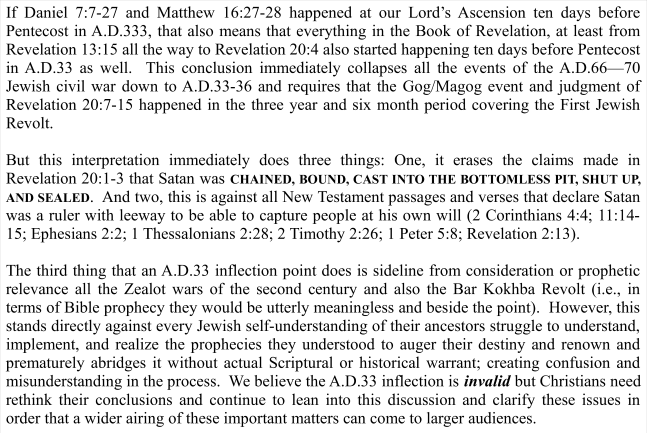
in A.D.33.
But a closer look at the contexts of the prophecies in Daniel 7:7-27 and Matthew 16:27-28 will demonstrate to anyone who will widen the scope of the inquiry (particularly in Daniel 7:7-27) that the event in question could not have happened at our Lords Ascension. Moreover, even Matthew 16:27-28 forbids itself from being fulfilled directly adjacent to Christ’s earthly ministry by the fact that it promises the Son of man coming in the glory of his Father WITH his angels to judge every man according to their works BEFORE everyone there at Caesarea Philippi had tasted of death.
The entire prophecy of Matthew 16:27-28 actually forbids itself from being fulfilled when the majority says it was—but what is more, it also denies that it could be fulfilled outside the lifetime of everyone that heard it in the first place!11
Other Issues
The deconstruction of the notion that a more than nineteen century last days is Biblical can have its starting point with people questioning their assumptions about how to interpret Daniel 7:7-27, Matthew 16:27-28 and how and where the events of the Book of Revelation fit in in direct connection with events in first and second century Jewish and Israelite history. Of course, these nineteen-centuries-long last days that most Christians believe in is not presently considered odd or strange (even though they should be). An 89-year-old terminal patient living in his ‘last days’ should not be able to live three times as long after his diagnosis if it was correct at all! In the same way in the first century, the Mosaic era was fourteen centuries old and its State Temple and animal sacrificial apparatus passed away forever within one hundred years after the Apostles made it clear the last days were in force (Acts 2:17; 2 Timothy 3:1 cf. Hebrews 1:1).12
Christians grappling with Daniel 7:7-27, and Matthew 16:27-28, can end up bearing a lot of fruit in this direction; their minds can be changed when they see new evidence and different Scriptural possibilities. And further, by rejecting concepts that their very own studies demonstrate to be completely out of the question, these research developments are a must in order to change the narrative and push the discussion in the direction of what happens in Revelation 12:5; 13:5, and Revelation 14:14-20; 16:15-21.13 The Bible itself offers a more reasonable interpretation than the one that says Daniel 7:7-27 and Matthew 16:27-28 were arbitrarily fulfilled, without any social unrest, genocidal commotion, or war, just ten days before Pentecost in A.D.33.14
Endnote
1 On the question of how to understand Revelation 20 and the millennium, Matthew 12:43-45 puts a decisive limit upon it and Christians will doubtlessly struggle with the meaning of a millennial period that lasted only a single generation between the two Herculian Hebrew revolts, but the love of Jesus and submission and respect for the word of his authority about the events of that specific generation will surely to win the day, in the final analysis.
2 Pray and patiently study the Apostle Paul’s words in 2 Corinthians chapter 3:1-18.
3 Study the significance of the worldly sanctuary in Hebrews 9:1-27 and 10:1.
4 On the implementation of the perpetual twice daily sacrifices and oblations see Numbers 28:2-6. The destruction of the Second Temple during the forty-two-month-long civil war meant that this critical observance can no longer happen (Revelation 11:2 cf. 13:5). Along with the destruction of the State Temple the Aaronic priesthood has been dissolved (Hebrews 7:11-19). The historian Josephus preserves a record of the steps the Zealots took to terminate the Aaronic priesthood in Wars of the Jews 4.3.8:155-157).
5 https://seedbed.com/3-jewish-feasts-old-testament-know/
6 The appearance of a Messianic king along with a Messianic prophet is what we witness happen in Revelation 13:5 and 11.
7 Yehoshafat Harkabi, The Bar Kokhba Syndrome, p.41, 1982.
8 Even though it was perfectly clear to me what the Bible said about the Second Coming being very near, still all that same time, the idea still seemed ‘crazy’ to me. It was only until I read Josephus’ Wars of the Jews 6.5.3:288-300 (quoted here) and Tacitus in his Histories records similarly bizarre events at the very beginning of that great war:
“Prodigies had occurred, which this nation, prone to superstition, but hating all religious rites, did not deem it lawful to expiate by offering and sacrifice. There had been seen hosts joining battle in the skies, the fiery gleam of arms, the temple illuminated by a sudden radiance from the clouds. The doors of the inner shrine were suddenly thrown open, and a voice of more than mortal tone was heard to cry that the gods [sic!] were departing. At the same instant there was a mighty stir as of departure. Some few put a fearful meaning on these events, but in most there was a firm persuasion, that in the ancient records of their priests was contained a prediction of how at this very time the East was to grow powerful, and rulers, coming from Judaea, were to acquire universal empire. These mysterious prophecies had pointed to Vespasian and Titus, but the common people, with the usual blindness of ambition, had interpreted these mighty destinies of themselves, and could not be brought even by disasters to believe the truth.”
After seeing this report in the Appendix of Josephus’s Complete Works I was finally able to have that assurance that a real tangible historical event, though prodigious and anomalous, had actually already happened.
9 The change can happen by reading everything in Daniel 7:7-27 and reflecting on exactly what it all means instead of narrowly focusing on the language and meaning of Daniel 7:13 only.
10 Whenever Christians begin to question why they believe Jesus came in the glory of his Father with his angels to judge every man at the Ascension, that is the time when movement toward a different consideration may begin, but not before.
11 It has to become crystal clear to people that the prophecy of Matthew 16:27-28 cannot happen so soon that nobody had died and nobody was judged, and also that nobody was rewarded. At the same time, it has to emerge in the imagination that the prophecy cannot happen so far away from the first century that all of the people who witnessed Christ say this have ‘tasted of death.’
12 As understanding increases the end of the age transforms from being about the last days of the planet earth or human civilization to the terminal days of the Second Temple and the Law of Moses, exactly the issues that got Saint Stephen in serious trouble in Acts 6:9-14.
13 With Matthew 16:27-28 averting to events in the Book of Revelation, rather than prematurely in the Book of Acts, a brand new and unfamiliar vista opens up and research, exploration, and discovery promise a rich and exciting trove of stunning realities most have not begun to contemplate as realistic possibilities before now.
14 The upshot of this research will demonstrate, over time spent studying, that Jesus Christ was good and faithful to his word and did not prematurely fulfill or otherwise delay his Parousia in any way, shape, or form
*An explanation for ‘Lag B’Omar’ in Bible study chart 2, here.
